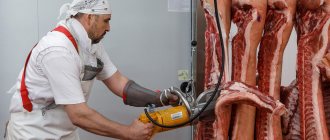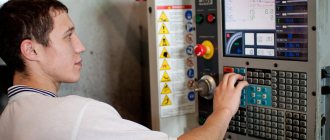Job description structure for a pastry chef
Although each employer has the right to develop job descriptions independently (the form of these documents is not defined by law), the job description of a pastry chef is often structured according to the following sections:
You can find more complete information on the topic in ConsultantPlus. Full and free access to the system for 2 days.
- General provisions.
- Functions and tasks.
- Job responsibilities.
- Rights.
- Responsibility.
- Operating mode.
This is an approximate list of sections of the document, which can be changed or supplemented if necessary. For example, at the end of the instructions you can indicate as notes that if emergency situations arise, the pastry chef must make decisions within his competence; If you can’t find a way out of the situation on your own, you need to contact the shop manager (higher manager).
Below we will consider each of the listed parts of the instructions in more detail. Let's start with the “Job Responsibilities” section, since it is the main one in the document.
History of the profession
It’s difficult to say when professional confectioners appeared, since people have always loved sweets: the Mayans used chocolate, the ancient Indians used sugar cane, the Egyptians learned to make sweets from dates.
In Europe, the profession of pastry chef as a specialized cook appeared in the courts of royalty and courtiers, and with the opening of private bakeries as commercial enterprises, the profession of pastry baker also emerged.
Responsibilities of a pastry chef
This section includes a list of responsibilities that are assigned to the pastry chef. These typically include the following:
- preparing the workplace and equipment for work;
- compliance with hygiene rules and sanitary standards when working;
- calculation of raw materials needed for preparing confectionery products;
- compliance with the rules of packaging and storage of products;
- carrying out primary processing of the obtained raw materials;
- compliance with ingredient consumption standards;
- compliance with the technological process of manufacturing products;
- compliance with equipment operation rules;
- production and release of products in accordance with approved rules;
- quality control of prepared products;
- packaging and labeling of finished products.
Note: the list of responsibilities presented above is advisory in nature, since the responsibilities of a pastry chef may vary depending on the place of work and its category. In addition, in large enterprises, as a rule, a separate specialist is responsible for each stage of the technological process: one kneads the dough, another is engaged in decoration, a third produces baked goods, a fourth is responsible for preparing the final product, etc.
How to become a pastry chef
Becoming a pastry chef is quite simple - you need to get an education, and you can enter a vocational school or college after the 9th grade, and upon graduation you will receive the qualification of a 3rd category pastry chef.
You can simply complete special courses, with the help of which you can understand what a more highly qualified confectioner does, and gradually reach the highest category - 6th.
To qualify for high positions in this field, it is worth obtaining a university diploma in the specialty “Technology of Products and Organization of Public Catering.”
General provisions, functions and tasks of the confectioner
The “General Provisions” section includes the following information:
Subscribe to our newsletter
Read us on Yandex.Zen Read us on Telegram
- the name of the position and place of work of the employee in accordance with the staffing schedule adopted at the enterprise;
- the procedure for appointing an employee and dismissing him from office;
- qualification requirements for candidates for the position;
- procedure for replacing a confectioner in the event of his absence;
- a description of the skills and abilities that the employee must have;
- a list of regulations and local acts, the provisions of which can guide the confectioner in his activities.
The section of the instructions “Functions and Tasks” includes an indication of the main type of activity of the confectioner, which is established depending on the type of enterprise - the place of work and the number of confectioners among whom the cooking responsibilities are shared. For example, if a worker's task is to make baked goods, the function might include, for example, learning the process of making them.
Requirements for a pastry chef
Usually the requirements for a pastry chef are very simple:
- education (vocational or short-term courses);
- work experience in the specialty;
- medical book.
Sometimes more skills and knowledge are required from the pastry chef:
- experience with certain ingredients;
- team management skills;
- experience in process control.
Rights, responsibilities and mode of operation of a confectioner
The “Rights” section includes a list of employee rights with which he is endowed for the proper performance of his duties. The confectioner has the right:
- refuse to use expired products for the manufacture of confectionery products;
- require relevant specialists to organize the operation of refrigeration and other equipment in the event of a breakdown;
- contact your boss with proposals for improving the process;
- interact with other services and other structural divisions, etc.
The “Responsibility” section of the job description can be presented in one of 3 options:
- Listing specific actions for which liability may arise. For example, it may be said that “failure to comply with the terms of the employment contract and the provisions of this document entails the application of disciplinary measures.”
- Indicating the types of responsibility to which the employee is involved. As a rule, we are talking about material (in case of damage to the employer’s property), disciplinary (in case of failure to perform or improper performance of duties), criminal (in case of committing a crime) and administrative (in case of committing an administrative offense).
- Referring to the norms of current legislation. In this case, formulations such as “the employee is responsible in accordance with the law” are used.
The “Working hours” section provides clarifications regarding the specifics of the confectioner’s work schedule, if any. In this case, we can talk about night shifts, duty, irregular working hours, etc.
JOB DESCRIPTION FOR CONFECTIONERY TECHNOLOGIST
Downloads: 723
I CONFIRM:
_____________________
"____"___________ 2005
1. GENERAL PROVISIONS.
1.1. This job description defines the functional responsibilities, rights and responsibilities of a confectionery and cream production technologist.
1.2. The confectionery and cream production technologist is appointed to the position and dismissed by the production director.
1.3. The confectionery and cream production technologist reports directly to the production director and deputy production director.
1.4. A confectionery and cream production technologist belongs to the category of managers.
1.5. An employee can be appointed to the position of confectionery and cream production technologist based on the interview results:
· with secondary specialized or higher education in the field of confectionery production,
· work experience as a manager of a confectionery or cream production or a technologist in a confectionery or cream production for at least 5 years,
· having experience as a confectioner from 1.5 - 3 years.
1.6 A confectionery and cream production technologist must know:
· decrees, orders, normative documents relating to the operation of public catering and confectionery enterprises,
· organization and technology of confectionery production
range and quality requirements for confectionery and cream products,
· organization of work of the confectioner,
· accounting rules and standards for issuing products,
· consumption rates of raw materials and semi-finished products,
· calculation of confectionery products and prices for them,
rules and terms of storage of raw materials and semi-finished products,
· technological processes for the preparation of confectionery, bakery and cream products, confectionery and cream semi-finished products,
· rules and regulations of labor protection, safety precautions, industrial sanitation and fire protection,
· types of technological equipment, operating principles, technical characteristics and operating conditions,
2. JOB RESPONSIBILITIES.
The confectionery and cream production technologist is obliged to:
2.1. Develops new types of confectionery and cream products, improves existing technologies and recipes for confectionery and cream products.
2.2. Controls technological processes in the production of confectionery and cream products, as well as the quality of finished products.
2.3. Control the number of write-offs in the confectionery and cream shops by item and in general in quantitative and total terms.
2.4. Control the volume of discounted products from the confectionery and cream shops in quantitative and total terms by item and in general.
2.5. Directs the activities of the workforce to ensure the rhythmic release of own-produced products of the required range and quality in accordance with the production task drawn up on the basis of consumer demand.
2.6. Controls the timeliness of production of confectionery products and their removal to the hall.
2.7. Carries out work to improve the organization of the production process, introduce progressive technology, effectively use equipment, improve the professional skills of workers in order to improve the quality of products.
2.8. Provides, based on a study of consumer demand, a diverse range of confectionery and cream products.
2.9. Carry out work to increase production volumes and profits.
2.10. Carries out constant monitoring of compliance with sanitary rules and personal hygiene standards.
2.11. Monitors compliance with production labor discipline and internal labor regulations.
2.12. When accepting raw materials, organoleptically evaluate the quality of raw materials and semi-finished products.
2.13. During the working day
- control the production technology of confectionery products and the standards for laying raw materials,
- strictly follow the recipe and standards for laying raw materials,
- is constantly at his workplace and leaves it only with the permission of the production director,
- treats technological equipment and kitchen and confectionery equipment with care, preventing their damage or deterioration,
— immediately report malfunctions of technological equipment to the head of the confectionery shop, production director and chief engineer,
- control the order and cleanliness of your production unit, technological equipment,
— monitor compliance with safety regulations and operating instructions for inventory, equipment and mechanization.
2.14. Comply with safety rules and operating instructions for inventory, equipment and mechanization.
2.15. The confectionery and cream production technologist is obliged to monitor shift employees in terms of their compliance with the terms of the agreement on collective financial responsibility, and take measures in accordance with the signed agreement on collective financial responsibility to ensure the safety of the material assets entrusted to him.
2.16. Inform the administration about all, without exception, facts that may negatively affect the business reputation of the enterprise, the moral and psychological climate of the team, or affect to one degree or another the state of the production process and the profit of the enterprise.
2.17. The confectionery and cream production technologist, in addition to the duties set out above, must fulfill reasonable requirements and instructions from the director of production, deputy director of production related to the work and given within the limits of their authority.
3. RIGHTS.
A confectionery and cream production technologist has the right:
3.1. Demand a fair and equal distribution of functional responsibilities in the confectionery shop during the work shift.
3.2. Endorse documents of management and personnel activities insofar as they relate to the performance of official duties by him, as well as by other employees who were or are related to the events, actions and facts in question.
3.3. Submit proposals to improve working conditions for management's consideration.
3.4. Require management to create normal conditions for the performance of official duties.
3.5. Make decisions within your competence.
4. RESPONSIBILITY.
4.1. The confectionery and cream production technologist is responsible for:
— timely and high-quality performance of duties assigned by the job description;
— inaccurate information about the state of affairs and performance of official duties;
— maintaining trade secrets and not disclosing any information obtained as a result of professional activities;
- offenses committed in the course of carrying out their activities - within the limits determined by the current administrative, criminal and civil legislation;
— causing damage (material or damage to business reputation) to the enterprise within the limits determined by the current labor and civil legislation;
- failure to comply with orders, instructions from the production director, deputy production director, related to work and given within the limits of their authority.
— violation of internal labor regulations, safety and fire safety regulations and sanitary and hygienic standards.
5. OPERATING MODE.
5.1. The work schedule of a confectionery and cream production technologist is determined in accordance with the terms of the employment contract and the Internal Labor Regulations established at the enterprise.
5.2. Due to production needs, a confectionery and cream shop technologist may be involved in work beyond the standard working hours.
Head of structural unit:
_______________ _________________________________00.00.00 (signature) surname, initials
AGREED:
Head of the legal department:
_______________ _________________________________00.00.00 (signature) surname, initials
Head of HR Department:
_______________ _________________________________00.00.00 (signature) surname, initials
I have read the instructions:
_______________ _________________________________00.00.00 (signature) surname, initials
Where to get training
In addition to higher education, there are a number of short-term training on the market, usually lasting from a week to a year.
The Institute of Professional Education "IPO" invites you to take distance courses in the direction of "Technology for the production of bread, confectionery and pasta" (there are options 256, 512 and 1024 academic hours) to receive a diploma or state-issued certificate. We have trained more than 8,000 graduates from almost 200 cities. You can undergo external training and receive interest-free installments.
Pastry chef salary
The salary level of a confectioner fluctuates around 20 - 70 thousand rubles per month. Minimum amounts are offered to production assistants or molders.
The average salary of a pastry chef is approximately 33 thousand rubles per month.
If you get a higher education and work for several years in the field, you can count on a very decent income. Let's say, when asked how much a pastry chef of some elite restaurant earns, no one will answer you - this is often a trade secret. For example, some Moscow restaurants are willing to pay confectioners even up to 200 thousand rubles.






